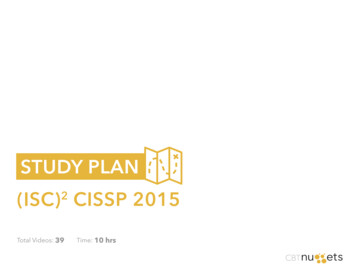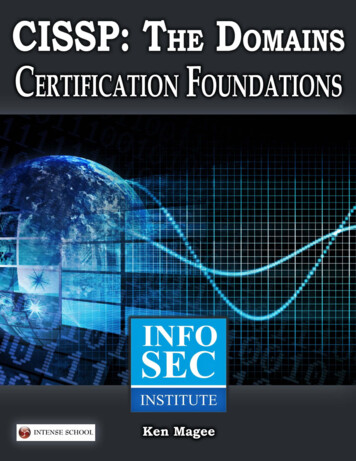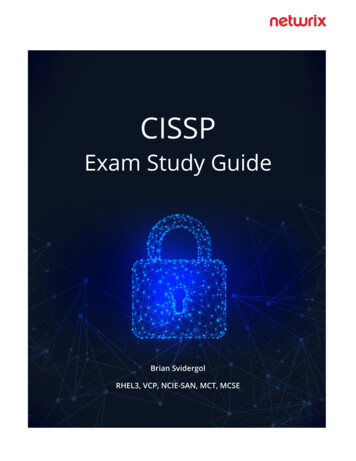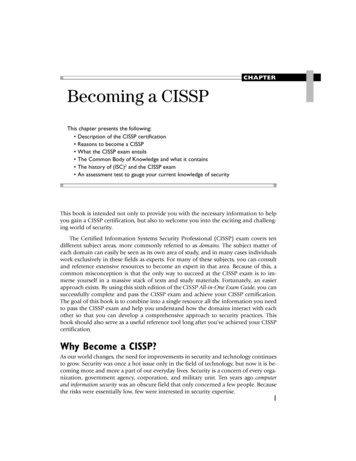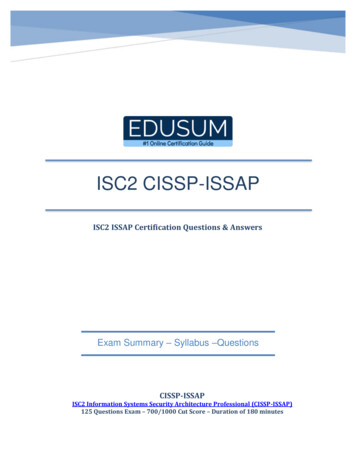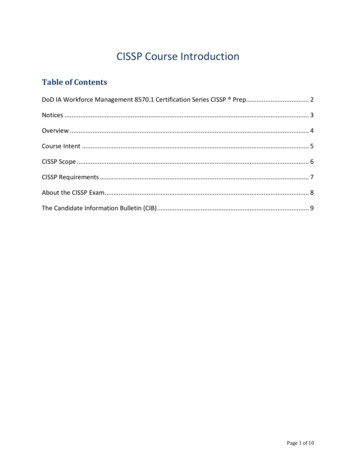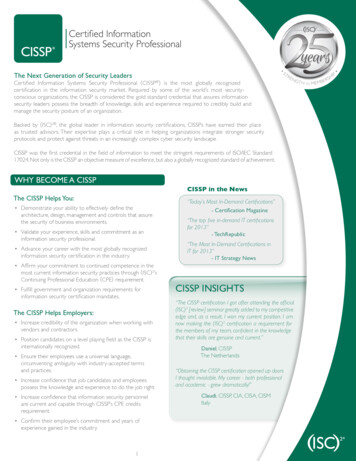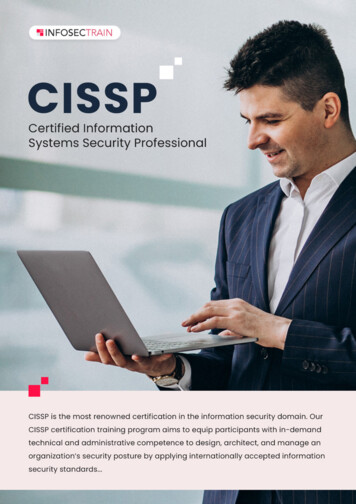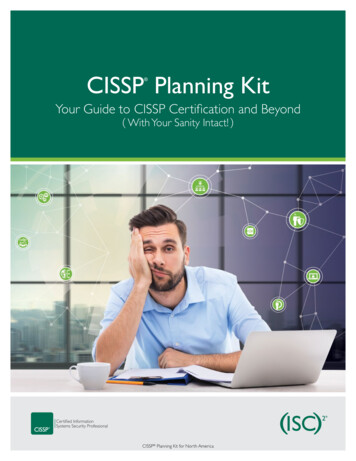
Transcription
CISSP Planning Kit Your Guide to CISSP Certification and Beyond( With Your Sanity Intact! )CISSP Planning Kit for North America
The Path to CISSP CertificationCan Be Complex.We’re here to help you navigate the planning process with easeCongratulations! You’ve discovered this amazing planning kitdesigned to guide you on your journey to CISSP certification.In the following pages, you’ll find:Fast facts about CISSPAn overview of the CISSP exam Your success roadmap (aka, planning and study tips) 5 Tips to help you maintain your CISSP certification 22 continuing education ideasAs the creators of the CISSP Common Body of Knowledge(CBK), we’re here to help navigate you through thecertification process. Contact us with any questions.CISSP Planning Kit for North AmericaHave questions? Email us at training@isc2.org2
Fast Facts About CISSPINTRODUCED IN 19944OVER140,000professionalshave obtainedCISSP certification250Number of CISSPcertification exam questionsLength of the typicalCISSP training courseAmount of timeallowed for taking theCISSP certificationexam(Training can range from 5 daysto 12 weeks depending ondelivery method)Amount of work experienceyou need to have in two ofthe domain areas required forCISSP certificationAmount of work experiencethat allows you to pursue theCISSP certification via theAssociate of (ISC)2Learn about domains on the next pageCISSP Planning Kit for North AmericaHave questions? Email us at training@isc2.org3
An Overview of the CISSP ExamWhat exam topics you will exploreThe CISSP is the industry-leading certification for information security professionals. When you earn your CISSP,it shows you have the knowledge and skills of a true expert. Ideally, through continuing professional education,you’ll be qualified throughout your lifetime!The CISSP exam itself covers 8 domain areas. Think of the domainsas specific knowledge areas you need to know based on yourprofessional experience and education. Some domains carry moreexam weight than others.If you’re intethe CISSP ex rested inamdownload it ITYSECURITYAND RISKMANAGEMENT10%16%10%SECURITYASSESSMENTAND TESTING16%11%12%COMMUNICATIONSAND NETWORKSECURITYSECURITYOPERATIONS13%12%IDENTITYAND ACCESSMANAGEMENTSECURITYENGINEERINGPercentages Weight on ExamCISSP Planning Kit for North AmericaHave questions? Email us at training@isc2.org4
Setting Yourself Up For SuccessGet prepared to rock your CISSP certificationGet familiar with the exam. The exam outline is a great place to start. It’s a free resource thatdetails the major topics and subtopics within the 8 domains you will be tested on in the CISSPexam. Reviewing this outline can help set you up for success as you prepare for the exam.Create urgency and develop a plan. Commit to an exam date early. This can help you staymotivated and allow you to work backwards as you create a study schedule. Stay on track and stickto a routine by blocking study time on your calendar each day.Invest in study materials, starting with the CBK guide book. Take advantage of the manyself-study resources available. From a traditional study guide to an on-the-go study app, (ISC)² offersseveral options to suit your study needs.Official (ISC)² Guideto the CISSP CBK,4th EditionOfficial (ISC)²CISSP Study Guide,7th EditionOfficial (ISC)²CISSP Practice TestsOfficial CISSPStudy AppCISSP Planning Kit for North AmericaCISSP for Dummies,5th EditionHave questions? Email us at training@isc2.org5
Review and refresh your knowledge through training. Attending a formal training once you’vebegun studying can help reinforce the topics you’ve already explored. Choosing official trainingfrom (ISC)² provides several benefits, like access to the most up-to-date content with a focuson real-world learning activities and scenarios. You’ll also be learning from an (ISC)²-authorizedinstructor who is an industry expert and certified CISSP. And, with diverse training options available- including in-person and online - you can pick what works best for you and your schedule.Classroom-basedPrivate, OnsiteLive OnLineOnDemandBrush up on less familiar topics. After your training, think about the topics that were coveredand if there were any areas where you could improve. Refer back to your study materials andreview those domains more closely as you continue to prepare.Practice, practice, practice! Now’s the time to assess your exam readiness by going throughrealistic practice questions. You can find these practice questions in your CISSP Practice Test Book,CISSP study app, and other study materials. Once you’re acing the practice exams, you should feelconfident that you’re ready to take on the real thing!Catch some ZZZs. Try to relax in the days leading up to your exam. Go to bed at a reasonablehour the night before, and try to eat a healthy breakfast on the morning of your exam. Rememberthat the exam is 6 hours - you’ll probably want to bring along a snack, too.CISSP Planning Kit for North AmericaHave questions? Email us at training@isc2.org6
5 Tips to Help You MaintainYour CISSP CertificationThe best routes to keep you certifiedEarning the CISSP certification is a major career milestone! Of course, the journey doesn’t end withpassing the exam. Like most professional credentials, CISSP has continuing education requirements.Below are five ways you can accrue Continuing Professional Education (CPE) credits. Following these simple stepswill not only help you keep up with the rapidly evolving cybersecurity landscape and expand your knowledge,but will also allow you to maintain your CISSP status – meaning you won’t ever have to worry about taking theintense 6-hour exam again.1Track and record your CPEs.To maintain your CISSP certification you must earnand submit a minimum number of CPE credits duringeach of your three-year certification cycles, includinga minimum number of CPEs that must be earnedannually during each year of your three-year cycle.To keep it simple, set an auto-reminder or note onyour calendar to submit your CPEs. Keep in mind thatyou must have all CPEs submitted on the anniversaryof the date that you became certified.Rather than looking at your continuing educationrequirements as a nuisance or just another task tocross off your list, remember that education is alifelong journey.CISSP Planning Kit for North America2Understand CPE activities.As a professional, you are probably already doingthings that count toward your required CPEs.Get credit for it!Many activities count toward your CPE credits,including:Reading information security blogsAttending webinars or live eventsWriting articles or presenting to peersServing as a volunteer leader for a localinformation security chaptersYou can find a complete list of activities within thisplanning kit.Have questions? Email us at training@isc2.org7
3Utilize the free, ongoing optionsto earn CPE credits.It’s possible for you to earn all of your CPE creditswithout spending a dime. Seriously!Every month there are new learning opportunitiesoffered online, including:60-minute ThinkTank Security LeadershipRoundtable webinarsFrom the Trenches webinarsMonthly Security Briefings webinarsQuarterly InfoSecurity Professional e-magazine4Be aware there’s a grace period if you don’treport all of your CPE credits.Sometimes life gets in the way, and you may forgetto report CPEs. For example, you may have reachedthe end of your three-year renewal cycle and youhaven’t documented all of your CPEs yet.Luckily, there’s a 90-day grace period following thecertification expiration date to report CPEs to(ISC)2, but the credits must have been earned by theexpiration date. This provides some buffer room.The number ofCPE credits youremployees needeach year.CISSP Planning Kit for North AmericaHow muchtime the requiredCPEs equate toper month.And if the 90-day grace period just isn’t long enough .5Know that you can retake theCISSP exam if necessary.When all else fails, it’s possible for you to take theexam again to recertify as a CISSP. Yes, it’s a longexam, and there will be extra costs for you. Overall,though, it’s better than no longer holding the CISSPcredential.The good news is there’s usually no need for youto get endorsed again. It’s just a matter of youpassing the exam and contacting Member Servicesto reactivate your certification. Note that there is aUS 35 reinstatement fee upon recertification.The length oftime the CISSPcertification is goodfor before renewal.The total number ofcredits needed to stayCISSP certified by theend of three years.Have questions? Email us at training@isc2.org8
22 Activities that Qualifyfor CPE CreditsThere are many roads you can travelOnce you’ve achieved your CISSP, you can earn different types of CPE credits:Group A credits are for professional development activities that directly relate to thedomains covered by the CISSP exam. Of your 40 required credit hours per year, at least 30of them need to be from Group A.Group B credits are for everything else that enhances your general skills and competencies.There are no mandatory CPE credit requirements for Group B.Examples of ActivitiesGroup ATopic relates to aCISSP domain(s)Group A or BDepends onthe topicGroup BTopic does not relateto any CISSP domainsAttending educational training courses, seminars,conferences, vendor presentationsAttending vendor presentationsCompleting higher academic coursesPreparing for presentation/lecture/trainingPublishing a security article or bookPerforming board service for a professionalsecurity company or organization or its parentcompany (if one exists)Completing self-study, and attending computerbased training, webcasts and podcastsReading cyber security book/magazine, includingInfoSecurity Professional magazineReading white paperWriting a security white paperCISSP Planning Kit for North AmericaHave questions? Email us at training@isc2.org9
Activities That Qualify for Continuing Professional Education (CPE) Credits (Continued)Group A credits are for professional development activities that directly relate to thedomains covered by the CISSP exam. Of your 40 required credit hours per year, at least 30of them need to be from Group A.Group B credits are for everything else that enhances your general skills and competencies.There are no mandatory CPE credit requirements for Group B.Examples of ActivitiesGroup ATopic relates to aCISSP domain(s)Group A or BDepends onthe topicGroup BTopic does not relateto any CISSP domainsReviewing cyber-security bookVolunteering for government, public-sector, andother charitable organizationsVolunteering for and attending informationsystems/ cyber security professional associationchapter meetingSafe and Secure Online programPerforming unique projects and activitieson-the-jobPreparing new or updating existing trainingseminar or classroom materialManagement or accounting coursesEducation related to interpersonalcommunication skillsEducation related to interviewing techniquesEducation related to development skillsEducation related to project planning skillsEducation related to technical skills not information security — such as programminglanguages and techniquesCISSP Planning Kit for North AmericaHave questions? Email us at training@isc2.org10
About(ISC)² is an international nonprofit membership association focused on inspiring a safeand secure cyber world. Best known for the acclaimed Certified Information SystemsSecurity Professional (CISSP) certification, (ISC)² offers a portfolio of credentials thatare part of a holistic, programmatic approach to security.Our membership, over 115,000 strong, is made up of certified cyber, information,software and infrastructure security professionals who are making a difference andhelping to advance the industry.For more information about CISSP training in North America:toll-free 1.866.462.4777phone 1.703.891.6781emailtraining@isc2.orgCISSP Planning Kit for North AmericaHave questions? Email us at training@isc2.org11
CISSP for Dummies, 5th Edition Official CISSP Study App. . Best known for the acclaimed Certified Information Systems Security Professional (CISSP) certification, (ISC)² offers a portfolio of credentials that are par
